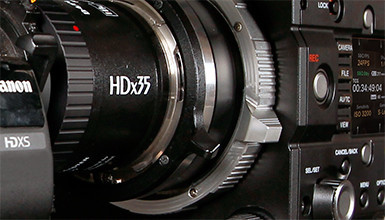
Recently, I tested the Zeiss Compact Prime CP.2 35mm Super Speed in several common shooting styles. I wanted to experiment with finding the best focal length for each situation. I chose the Zeiss CP.2 35mm Super Speed for two reasons: the lens covers the 6K sensor of the RED EPIC DRAGON I paired it with, and I also wanted to use the fast speed of the T1.5 to capture shallow depth of field in certain situations. It's also one of my favorite focal lengths, as it can achieve a variety of different looks and feels.
Interview
One of the reasons you choose a focal length is the physical location of your camera and the relationship to your subject. Do you want to be close to them or farther away? For the interview below, I wanted a focal length that would allow me to achieve a medium shot of the interviewee in his environment. I also needed to be physically close to him, as I was the one asking the questions. I wanted him to feel comfortable and have a conversation with me without the camera interfering.
The 35mm worked perfectly for this situation since I also wanted to control the perspective of the background. I wanted to see his background environment in a natural way, not in the compressed way that a longer focal length would produce. For this interview, I shot at T4 in order to have a depth of field that allowed the audience to see his environment and the restaurant's atmosphere just enough, but still maintain the focus on the interviewee. The perspective of the 35mm focal length makes it a great interview lens for these reasons.
Lens as a Character in a Narrative
Another thing to consider when choosing a focal length is how much attention you want to bring to the camera itself. Is it a character in your narrative? Are you involving the audience with the camera and your story? For the following scene, I wanted the audience to be a part of the narrative. In this intimate setting with the child, I wanted to be physically close to him and also have his facial features represented naturally. Since this lens has a close focus of one foot, I was also able to play with the narrow depth of field.
This is all shot at T1.5 in order to exaggerate the child's features as he interacted with the camera, as well as at 60 fps to dramatize the event. It starts out with his features represented naturally and moves in to an extremely narrow depth of field. You'll see at times only his ear is in focus. I wanted to create a dreamy feel and have the audience interact with the child in a playful way. This was all shot outside with available lighting.
You can also choose to use a lens to create anticipation; using a wide shot when most would use a close up. The first shot sets the scene, showing the subject in his environment beginning to blow bubbles, and you want to see more. I was also able to capture some nice flares with this focal length once the child's bubble landed on the filter. The 35mm focal length allowed me to capture a portrait and the environment. This video shows how the 35mm can be used for an establishing shot, as a character in your narrative, and as a way to achieve more dramatic emotions and audience responses.
Observational / Environmental Portrait
When the piece calls for a more observational feel, you want the camera and lens not to bring attention to themselves. You want the audience to see the action unfold in front of them naturally. For this scene, I chose the Zeiss CP.2 35mm Super Speed as it allowed me to create a poetic feel, and I wanted to let the subjects be in their natural environment. I also chose to include shots in this montage where the subjects did interact with the camera in order to show how the lens also unveiled nice environment portraits. I really enjoyed this focal length for children's faces and capturing their playful nature.
Throughout these tests, the Zeiss Compact Prime 35mm Super Speed was able to create a wide range of moods, tones and perspectives.
















